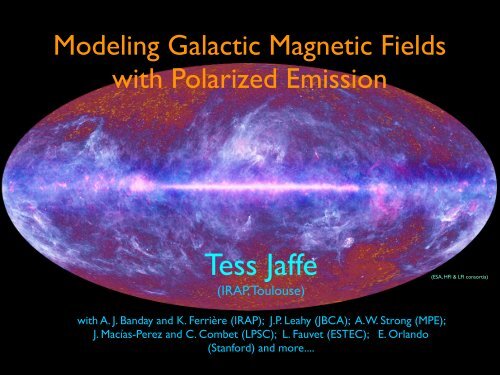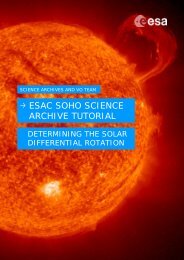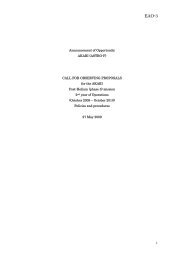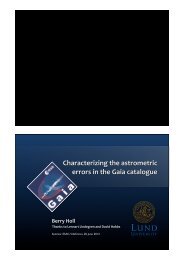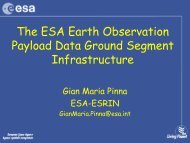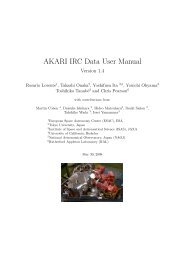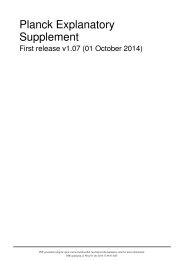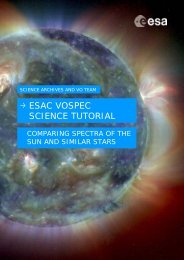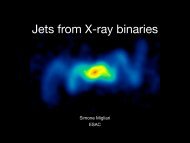Modeling Large-Scale Magnetic Fields in the Milky Way - ESA
Modeling Large-Scale Magnetic Fields in the Milky Way - ESA
Modeling Large-Scale Magnetic Fields in the Milky Way - ESA
- No tags were found...
You also want an ePaper? Increase the reach of your titles
YUMPU automatically turns print PDFs into web optimized ePapers that Google loves.
<strong>Model<strong>in</strong>g</strong> Galactic <strong>Magnetic</strong> <strong>Fields</strong>with Polarized EmissionTess Jaffe(IRAP, Toulouse)(<strong>ESA</strong>, HFI & LFI consortia)with A. J. Banday and K. Ferrière (IRAP); J.P. Leahy (JBCA); A.W. Strong (MPE);J. Macías-Perez and C. Combet (LPSC); L. Fauvet (ESTEC); E. Orlando(Stanford) and more....
Why are magnetic fields important?• They are everywhere. (The classical way to try to stump <strong>the</strong> colloquium speaker:“Have you considered <strong>the</strong> effect of ...?”)• They play key roles <strong>in</strong>:- primordial plasma physics;- galaxy formation and evolution;- hydrostatic balance <strong>in</strong> <strong>the</strong> ISM;- star formation via Parker <strong>in</strong>stability;- turbulence (<strong>the</strong> o<strong>the</strong>r traditional way to try to stump <strong>the</strong> speaker) <strong>in</strong> both <strong>the</strong>ISM and <strong>the</strong> IGM;- supernovae remnant expansion;- molecular cloud collapse;- ....• They are central to cosmic microwave background component separation.• They deflect ultra-high energy cosmic-rays (UHECRs).T. Jaffe @ <strong>ESA</strong>C, 30 May 2013
CMB foregrounds: Planck view(<strong>ESA</strong>, HFI & LFI consortia)•CMB observations <strong>in</strong> <strong>the</strong> sweet spotbetween different foregroundcomponents that would o<strong>the</strong>rwisedom<strong>in</strong>ate.•At low frequencies (few 10s of GHz),<strong>the</strong> synchrotron dom<strong>in</strong>ates <strong>the</strong> CMB.•At high frequencies (few 100s ofGHz), <strong>the</strong> dust dom<strong>in</strong>ates.•Both are polarized.=> <strong>Magnetic</strong> fields.WMAP teamT. Jaffe @ <strong>ESA</strong>C, 30 May 2013
ffν/GHzFor <strong>the</strong> analysis of AME we assume a fixed electron temperatureof 8000External galaxies:K for T e for all regions, fitt<strong>in</strong>g only foroneEM. Noteexamplethat this is not <strong>the</strong> true EM but an effective EM over <strong>the</strong> 1 ◦ radiusaperture. We also allowed made fits allow<strong>in</strong>g T e to vary, <strong>the</strong>results of which are presented <strong>in</strong> Section 5.6.The <strong>the</strong>rmal dust is fitted us<strong>in</strong>g a modified black body fit,S td = 2 h ν3c 2 1e hν/kT d − 1τ 250 (ν/1.2THz) β dΩ, (6)fitt<strong>in</strong>g for <strong>the</strong> optical depth τ 250 ,<strong>the</strong>dusttemperatureT d and <strong>the</strong>emissivity <strong>in</strong>dex β d .TheCMBisfittedus<strong>in</strong>g<strong>the</strong>differential of ablack-body at T CMB = 2.726 K:( ) 2kΩν2S cmb =c 2 ∆T CMB . (7)where δT CMB is <strong>the</strong> CMB fluctuation temperature <strong>in</strong> <strong>the</strong>rmodynamicunits. The sp<strong>in</strong>n<strong>in</strong>g dust is fitted us<strong>in</strong>gS sp = N H j ν Ω. (8)where we use a model for j ν calculated us<strong>in</strong>g <strong>the</strong> SPDUST (v2)code of Ali-Haïmoud et al. (2009); Silsbee et al. (2011). For <strong>the</strong>majority of sources we use fixed parameters appropriate to <strong>the</strong>Warm Ionized Medium (WIM) fitt<strong>in</strong>g only for <strong>the</strong> amplitude NHsdwhich has a peak frequency of ≈ 28 GHz. In a few sources, <strong>the</strong>peak frequency appears to be at a lower frequency, <strong>in</strong> which casewe fit a Warm Neutral Medium (WNM) model, with a peak frequencyof ≈ 23 GHz.The least-squares fit was calculated us<strong>in</strong>g <strong>the</strong> MPFIT 8(Markwardt 2009) packagewritten<strong>in</strong>IDLwithstart<strong>in</strong>gvaluesestimated from <strong>the</strong> data. We constra<strong>in</strong>ed amplitude parameters tobe positive and for <strong>the</strong> CMB fluctuation to be −150 < ∆T CMB
External galaxies: o<strong>the</strong>r examplesNGC6946 6cm PI over Hα (Copyright R. Beck, MPIfR)(Soida et al. 2002)A variety of morphologies observed, and we cannot assume a relationshipwith o<strong>the</strong>r matter tracers.T. Jaffe @ <strong>ESA</strong>C, 30 May 2013
Vertical fields <strong>in</strong> external Galaxies’• More often than not, thickdisk (“halo”) fields rema<strong>in</strong>parallel to <strong>the</strong> plane. Butnot always, as seen here.• Aga<strong>in</strong>, we cannot see ourslike this or <strong>the</strong> fielddirection.• (Note: “thick disk” oftenreferred to as <strong>the</strong> ”halo”,extend<strong>in</strong>g of order a fewkpc off <strong>the</strong> plane.)Copyright Cracow ObservatoryT. Jaffe @ <strong>ESA</strong>C, 30 May 2013
Small-scale field: TurbulenceEMLS I and PI (Uyaniker et al. 1999)<strong>Magnetic</strong> energy spectrum from pulsar data (Han et al.2004)T. Jaffe @ <strong>ESA</strong>C, 30 May 2013
Observables• Synchrotron emission:i.e. traces component perpendicular to LOS• Rotation measure:i.e. traces component parallel to LOS and issensitive to <strong>the</strong> direction• Thermal dust emission: ? i.e. traces component perpendicular to LOSbut depends on dust environment, gra<strong>in</strong> sizes and shapes, alignment mechanisms....• Starlight polarization, Zeeman splitt<strong>in</strong>g, masers, etc.• But: electron distributions not well known, dust polarized emission process not well known, datacontam<strong>in</strong>ated with o<strong>the</strong>r stuff (bremsstrahlung, CMB, <strong>in</strong>tr<strong>in</strong>sic RM, etc.)(Courtesy J.F. Macías-Pérez)T. Jaffe @ <strong>ESA</strong>C, 30 May 2013(Courtesy R. Wieleb<strong>in</strong>ski)
GeometryCoherent• Coherent contributes to RM for B|| and to Iand PI for Bperp.• Ordered random (i.e., <strong>the</strong> anisotropy <strong>in</strong> <strong>the</strong>turbulence) contributes to I and PIperpendicular, but to RM variance only.• Isotropic random contributes only to I and toPI and RM variance.RM > 0σRM = 0I = 0PI = 0RM = 0σRM = 0I > 0PI > 0Ordered randomRM = 0σRM = 0I > 0PI > 0Isotropic random•(At high frequencies, outside of Faradayregime.)• Careful when discuss<strong>in</strong>g “regular”, “random”,“turbulent”, etc.RM = 0σRM > 0I = 0PI = 0•Want I and PI at <strong>the</strong> same wavelength, butcannot on <strong>the</strong> plane.•Of previous results, only Jansson&Farrar takethis component <strong>in</strong>to account.RM = 0σRM > 0I > 0PI = 0σPI > 0T. Jaffe @ <strong>ESA</strong>C, 30 May 2013
Radio Observations408 MHz total <strong>in</strong>tensity (Haslam et al. 1982) 23 GH polarized <strong>in</strong>tensity (Page et al. 2007)Faraday rotation measure (RM) 1.4 GHz(Taylor et al. 2010) Not shown: SGPS,CGPS, VLA data along <strong>the</strong> plane.T. Jaffe @ <strong>ESA</strong>C, 30 May 20131.4 GHz polarized <strong>in</strong>tensity(Wolleben et al. 2006, Testori et al. 2008)
A very brief review of recent workT. Jaffe @ <strong>ESA</strong>C, 30 May 2013
RM-based model<strong>in</strong>g• With RMs, can study direction of field (from RM mean) andamount of turbulence along LOS (from RM variance).• Pulsar distance estimates probe along LOS, while extragalacticsources give better sampl<strong>in</strong>g and probe full disk.• But uncerta<strong>in</strong>ties <strong>in</strong> <strong>the</strong>rmal electron distribution as well asrelated pulsar distance determ<strong>in</strong>ations.• The only certa<strong>in</strong>ty is that <strong>the</strong>re are puzzl<strong>in</strong>g reversals.(Vallée et al. 2005)van Eck et al. (2011)T. Jaffe @ <strong>ESA</strong>C, 30 May 2013(Han et al. 2006)
Field reversals?• Reversals => dynamos or primordial?Example of numerical simulation of fieldgenerated by CR-driven dynamo <strong>in</strong> barredspiral (Kulpa-Dybełl et al. 2011)• Need a more detailed understand<strong>in</strong>g ofwhere <strong>the</strong> fields are reversed, i.e. moreGalactic pulsar RMs.Examples of formation of bisymmetric spiral (BSS, left) or r<strong>in</strong>g reversal(right) from primordial field (Sofue et al. 2010)T. Jaffe @ <strong>ESA</strong>C, 30 May 2013
RM + synchrotron models• Complementary observables to constra<strong>in</strong>both LOS and plane-of-sky fieldcomponents.• Sun et al. (2008): RMs and synchrotron,<strong>in</strong>clude 1.4 GHz depolarization and EM analysis,both <strong>in</strong> <strong>the</strong> plane and off. But idealized CREsand B-field components. Unknown effect oflocal structures.(Sun et al. (2008)(courtesy X Sun. & W. Reich)• Jansson et al. (2009,2012): 23 GHz andRMs, MCMC analysis, vertical structure,“striated” (=”ordered random”) component<strong>in</strong>cluded (2012). But excludes plane, notprob<strong>in</strong>g full disk. Unknown effect of localstructures.• Only Jansson et al. take <strong>in</strong>to account <strong>the</strong>anisotropic turbulence, i.e. <strong>the</strong> “orderedrandom” field.T. Jaffe @ <strong>ESA</strong>C, 30 May 2013Jansson & Farrar (2012)
Local structure?• Sky visibly dom<strong>in</strong>ated by spurs and loops. How reliable are fits of large-scalefield models to synchrotron polarization?North polar spur (NPS)aka “Loop I”Synchrotron map at 408 MHz (Haslam et al. 1982).Figure from Page et al. (2007)T. Jaffe @ <strong>ESA</strong>C, 30 May 2013
First look at <strong>the</strong> plane• Step features <strong>in</strong> I: arm tangents?• Peaks and troughs <strong>in</strong> RM: arms?• Reversals?T. Jaffe @ <strong>ESA</strong>C, 30 May 2013
<strong>Model<strong>in</strong>g</strong>: hammurabi• Hammurabi Code* (Waelkens, Jaffe, et al. 2009)• HEALPix scheme for LOS <strong>in</strong>tegration of:• Faraday RM;• synchrotron I, Q, and U (with Faradayrotation applied);• <strong>the</strong>rmal dust I, Q, U (ditto);• (EM);• (DM)...• Modular C++; add your own models.1.4 GHz polarized <strong>in</strong>tensity* Publicly available on Sourceforge:http://sourceforge.net/projects/hammurabicode/23 GHz polarized <strong>in</strong>tensity(Courtesy A. Waelkens.)T. Jaffe @ <strong>ESA</strong>C, 30 May 2013
Model <strong>in</strong>puts:Motivated by external galaxies:- 3D magnetic field model:• spiral arm model for ‘coherent’ field;• small-scale turbulence based on GRF with powerlawspectrum;• compression model amplifies and stretches <strong>in</strong>toanisotropic (‘ordered’) component along armridges based loosely on Broadbent (1989).- 3D CRE density and spectral model- 3D <strong>the</strong>rmal electron density model, e.g., NE2001(Cordes and Lazio 2002);- Hammurabi to <strong>in</strong>tegrate observables along LOS;- MCMC (cosmoMC) eng<strong>in</strong>e to explore parameterspace.=> Powerful tool to- study <strong>the</strong> magnetized ISM us<strong>in</strong>g <strong>in</strong>formation from radioto γ-ray, and- to simulate polarized foregrounds with realisticturbulence for test<strong>in</strong>g component separation forcosmology (for PRISM or Pixie).T. Jaffe @ <strong>ESA</strong>C, 30 May 2013
Cartoon example:T. Jaffe @ <strong>ESA</strong>C, 30 May 2013
Cartoon example:coherent• With a reasonable estimate for ne,RMs give Bcoh.T. Jaffe @ <strong>ESA</strong>C, 30 May 2013
Cartoon example:coherent+ isotropic random• With a reasonable estimate for ne,RMs give Bcoh.• Added simple homogeneous,isotropic GRF produces most of <strong>the</strong>total I but not its morphology.T. Jaffe @ <strong>ESA</strong>C, 30 May 2013
Cartoon example:coherent+ isotropic random+ <strong>in</strong>homogeneous• With a reasonable estimate for ne,RMs give Bcoh.• Added simple homogeneous,isotropic GRF produces most of <strong>the</strong>total I but not its morphology.• Amplification of random field <strong>in</strong>arms (<strong>in</strong>homogeneous), but stillisotropic, can fit total I but not PI.T. Jaffe @ <strong>ESA</strong>C, 30 May 2013
Cartoon example:coherent+ isotropic random+ <strong>in</strong>homogeneous+ anisotropic• With a reasonable estimate for ne,RMs give Bcoh.• Added simple homogeneous,isotropic GRF produces most of <strong>the</strong>total I but not its morphology.• Amplification of random field <strong>in</strong>arms (<strong>in</strong>homogeneous), but stillisotropic, can fit total I but not PI.• Random field stretched along arm giv<strong>in</strong>g“ordered random “ component <strong>in</strong> additionto <strong>the</strong> isotropic random component.T. Jaffe @ <strong>ESA</strong>C, 30 May 2013
Cartoon example:coherent+ isotropic random+ <strong>in</strong>homogeneous+ anisotropic• With a reasonable estimate for ne,RMs give Bcoh.• Added simple homogeneous,isotropic GRF produces most of <strong>the</strong>total I but not its morphology.• Amplification of random field <strong>in</strong>arms (<strong>in</strong>homogeneous), but stillisotropic, can fit total I but not PI.• Random field stretched along arm giv<strong>in</strong>g“ordered random “ component <strong>in</strong> additionto <strong>the</strong> isotropic random component.=> With three observables,constra<strong>in</strong> three field components:Bcoh, Biso, and BordT. Jaffe @ <strong>ESA</strong>C, 30 May 2013
First results:• 8 parameters fit: φ0, a0 - a4(arms+r<strong>in</strong>g), BRMS, ford.• Orientation of spiral matches NE2001ne model.• Reversal <strong>in</strong> Scutum-Crux arm and“molecular r<strong>in</strong>g”.• Coherent, isotropic random, orderedfield energy densities <strong>in</strong> ratios of 1:5:3(roughly 2, 4, and 3 μG along armridges, but this is model dependent).• Weak Sag-Car<strong>in</strong>a arm? Mentioned <strong>in</strong>Benjam<strong>in</strong> et al. (2005) us<strong>in</strong>g GLIMPSEcounts. Two dom<strong>in</strong>ant arms?Reversals?Jaffe et al. (2010)Ma<strong>in</strong> limitation: assumes simple power-law CRE spectrum from 0.1 to 1000 GeV. ButCRE spectrum is degenerate with ford. To break <strong>the</strong> degeneracy, need an additionalfrequency.Interest<strong>in</strong>gly, 2.3 GHz total I is not compatible with this model!T. Jaffe @ <strong>ESA</strong>C, 30 May 2013
CREs: or, real life isn’t always a power law.• Next step: l<strong>in</strong>k <strong>in</strong> GALPROP code of Strong and Moskalenko (2001)! Selfconsistent<strong>in</strong> <strong>the</strong> sense that GALPROP is given <strong>the</strong> same magnetic field fromhammurabi.• Use full <strong>in</strong>tegration over CRE energy spectrum at each po<strong>in</strong>t <strong>in</strong> <strong>the</strong> 3D galaxymodel:(see e.g. Rybicki & Lightman)• Add a synchrotron data po<strong>in</strong>t: 2.3 GHz total I from Jonas et al. (1998).• Add CRE model constra<strong>in</strong>ed by gamma-ray data (<strong>in</strong>verse Compton from <strong>the</strong>same electrons); see Strong et al. (2010).T. Jaffe @ <strong>ESA</strong>C, 30 May 2013
CRE results:0.408 GHz(total I)2.3 GHz(total I)solar modulation23 GHz(PI)previously assumedJaffe et al. (2011)(See also Strong, Orlando, & Jaffe 2011)• F<strong>in</strong>d below few GeV, J(E)∼E -1.3 ,slightly harder than usuallyassumed, compared to J(E)∼E -2.3above.• Note that at lower energies, solarmodulation affects localmeasurements.• Consistent with Strong, Orlando,& Jaffe (2011) high-latitude studyfrom 40 MHz to 23 GHz.• Two results: firstly, betterconstra<strong>in</strong>t on B-fieldcomponents. Secondly,constra<strong>in</strong>t on low-energy endof CRE spectrum o<strong>the</strong>rwise<strong>in</strong>accessible.T. Jaffe @ <strong>ESA</strong>C, 30 May 2013
Dust: ongo<strong>in</strong>g worksynch total Isynch PIsynch PI/Idust total Idust PIdust PI/IRM• Simple model for <strong>the</strong>rmal dust polarization doesnot work even with sub-grid PI/I of 30%. How<strong>in</strong>terest<strong>in</strong>g!• Note also problem with VLA data. No simplespirals!• Polarization degree significantly under-predicted=> dust emission com<strong>in</strong>g from regions with moreordered fields.• This means we can beg<strong>in</strong> to separate arm ridges <strong>in</strong>different components.• Cannot do it by chang<strong>in</strong>g dust distribution alone.• This could be tell<strong>in</strong>g us about <strong>the</strong> detaileddistribution of <strong>the</strong> magnetic fields even from ourposition with<strong>in</strong> <strong>the</strong> disk.• WMAP just sensitive enough to get a first look butnot more than a qualitative analysis. Needs Planck!Jaffe et al. (2013.)T. Jaffe @ <strong>ESA</strong>C, 30 May 2013
Spiral arm ridges: separable?Spiral arm shock trigger<strong>in</strong>g star formation? CO and microwave-band dust trace relativelycold molecular clouds, whose collapse is triggered <strong>in</strong> <strong>the</strong> shock. Downstream, star formationheats PAHs and dust that emit <strong>in</strong> sub-mm (ISO). So CO at shock front, star formationtrail<strong>in</strong>g? What does this mean for <strong>the</strong> magnetic field components?M51 component ridges, Patrikeev et al. (2011)T. Jaffe @ <strong>ESA</strong>C, 30 May 2013
Spiral arm ridges: separable?synch total Isynch PIsynch PI/Idust total Idust PIdust PI/IRMJaffe et al. (2013)T. Jaffe @ <strong>ESA</strong>C, 30 May 2013
Arm modulation?• Model of shock compression <strong>in</strong> spiral arms predicts roughly a factor of four ratiobetween pre- and post-shock for <strong>the</strong> component of <strong>the</strong> fields parallel to <strong>the</strong> shock,for <strong>the</strong> gas and dust, and at least that for <strong>the</strong> CREs.• This is not observed <strong>in</strong> synchrotron <strong>in</strong> external galaxies (e.g. M51) but it’s not clearwhe<strong>the</strong>r <strong>the</strong> observations have <strong>the</strong> resolution given that <strong>the</strong> shock region could befairly narrow.• CRE sources are also not uniformly distributed, and <strong>the</strong> CREs may rema<strong>in</strong> highly<strong>in</strong>homogeneous if <strong>the</strong> diffusion is highly anisotropic. Two effects, one <strong>in</strong> shock and onedownstream, effectively smooth<strong>in</strong>g it out?M51 and field by Fletcher et al. (2011)T. Jaffe @ <strong>ESA</strong>C, 30 May 2013Effenberger et al. (2012)
Planck:Planck and IRAS composite image (<strong>ESA</strong>).• Planck project on large scale magnetic fieldmodel<strong>in</strong>g us<strong>in</strong>g polarized dust mapped withunprecedented precision.• Us<strong>in</strong>g magnetic field geometry constra<strong>in</strong>ed byRM and synchrotron, we can study <strong>the</strong> dustdistribution <strong>in</strong> <strong>the</strong> disk of <strong>the</strong> Galaxy.• Polarized dust emission is <strong>the</strong>n acomplementary observable <strong>in</strong>dependent ofCRE or <strong>the</strong>rmal electron distributionuncerta<strong>in</strong>ties affect<strong>in</strong>g synchrotron.• Can we probe polarized emissivity, e.g. as afunction of dust temperature, radiative torquemechanisms, etc.?• Informed by model<strong>in</strong>g of gra<strong>in</strong> alignmentprocesses from detailed studies of smallregions, and perhaps vice versa.T. Jaffe @ <strong>ESA</strong>C, 30 May 2013
Small scales: turbulence and depolarization• depth depolarization, superposition of emission from a chang<strong>in</strong>g magnetic fielddirection along <strong>the</strong> l<strong>in</strong>e of sight; •Faraday depth depolarization, where at low frequencies, emission rotated as itpropagates (a.k.a. differential Faraday rotation);• beam depolarization, polarization orientation changes with<strong>in</strong> <strong>the</strong> observ<strong>in</strong>gbeam.•=> Can model “Faraday screen”, polarization “canals”, and polarization“horizon”.T. Jaffe @ <strong>ESA</strong>C, 30 May 2013
<strong>Magnetic</strong> field model<strong>in</strong>g plansToo long “To Do” list:NPS★ <strong>the</strong> “Fan” region vs <strong>the</strong> depolarization band?=> scale height, outer turbulence scale, galaxy dynamics,MHD...Fan★ <strong>the</strong> North Polar Spur (NPS)?=> o<strong>the</strong>r spurs, microwave “haze”, or Fermi bubbles (seee.g. Caretti et al. 2013)?• high-latitude sky global or local? can we predict CR deflections?• starlight polarization and dust ext<strong>in</strong>ction from Gaia?• supernova remnant polarization morphologies?=> <strong>in</strong>dependent probe of ambient field geometry• <strong>the</strong> halo field, vertical structure, and CRE distribution?• Galactic bar?• which <strong>the</strong>oretical models of field amplification (e.g. CR-drivendynamo, etc.) are consistent with <strong>the</strong> observed morphology?• ...• C-BASS, S-PASS, GALFACTS, LOFAR, ASKAP,SKA, Gaia!FanNPSDepolarization bandTop: WMAP 23 GHz polarized <strong>in</strong>tensity.Bottom: 1.4GHz polarized <strong>in</strong>tensity (Reich & Testori)T. Jaffe @ <strong>ESA</strong>C, 30 May 2013
Radio spurs, microwave haze, and Fermi bubbles?Radio spurs: nearby SNRs? Or galacticcenter outflows? Understand<strong>in</strong>g <strong>the</strong>“depolarization horizon” will help toplace lower limits on <strong>the</strong> distance to<strong>the</strong> polarized emission.S-PASS view by Carretti et al. (2013)Top: 1.4GHz, bottom 23GHzT. Jaffe @ <strong>ESA</strong>C, 30 May 2013
Υ-ray gradient problem?• CREs that produce synchrotron alsoproduce Υ-rays through InverseCompton and gas collisions.Observed angular distributiondepends on:- Cosmic ray source distribution?Assumed supernovae, follow<strong>in</strong>gpulsars.- Anisotropic diffusion? Degenerate.- Vertical distribution scale height?Difficult to measure, 1
Prospects:• C-Band All Sky Survey (C-BASS) full sky, full Stokes, at 5 GHz. Important for CMB componentseparation, synchrotron and magnetic field model<strong>in</strong>g, etc.• GALFACTS polarization survey at 1.4GHz from Arecibo. An order of magnitude more extragalactic RMsources as well as diffuse polarized emission for RM syn<strong>the</strong>sis. Can use hammurabi to model turbulence,depolarization horizon, SNa remnants, RM syn<strong>the</strong>sis test<strong>in</strong>g, ....• LOFAR to model fields <strong>in</strong> Galactic halo, particularly where fields weak, ionized gas tenuous.• PILOT, PIXIE, PRISM (?) for post-Planck sub-millimeter polarization• SKA...GALFACTS field (George et al., ADASS, 2010)T. Jaffe @ <strong>ESA</strong>C, 30 May 2013SKA simulation (Cordes)
External galaxies:• Most of <strong>the</strong> same questions apply.• A variety of morphologies are apparent <strong>in</strong>polarized emission, with magnetic arms often,but often not, follow<strong>in</strong>g arms seen <strong>in</strong> gas tracers.• Will use modified hammurabi to model whatwe will see with LOFAR and SKA (and maybeALMA for dust?).• Easier than our own Galaxy because we canlook from outside.• Harder because of a lack of RM measurements.But...M51 <strong>in</strong> optical (HST) with radio (5 GHz, VLA & Effelsberg)<strong>in</strong>tensity contours and field directionsT. Jaffe @ <strong>ESA</strong>C, 30 May 2013
SKA!SKA will allow Faraday RM measurements of background sources to getnot only orientation but direction: reversals?Shamelessly stolen figure, simulation from B. Gaensler of M31with ~10000 background RM sources expected with SKA!T. Jaffe @ <strong>ESA</strong>C, 30 May 2013
Conclusions:(wake up!)• It’s a very excit<strong>in</strong>g time to be study<strong>in</strong>g galactic magnetic fields.• You need many different and complementary observables to study <strong>the</strong>galactic magnetic field.• The days of conflict<strong>in</strong>g models be<strong>in</strong>g consistent with <strong>the</strong> data due todegeneracies and uncerta<strong>in</strong> <strong>in</strong>puts are numbered.• In <strong>the</strong> process of attempt<strong>in</strong>g to model <strong>the</strong> magnetic fields, we learnabout th<strong>in</strong>gs from CRE spectra to dust distribution, shock compressionprocesses, and gra<strong>in</strong> alignment.• The fact that our models don't fit very well is a Good Th<strong>in</strong>g. It means<strong>the</strong>re's a lot of <strong>in</strong>formation <strong>the</strong>re and a lot to do.T. Jaffe @ <strong>ESA</strong>C, 30 May 2013


